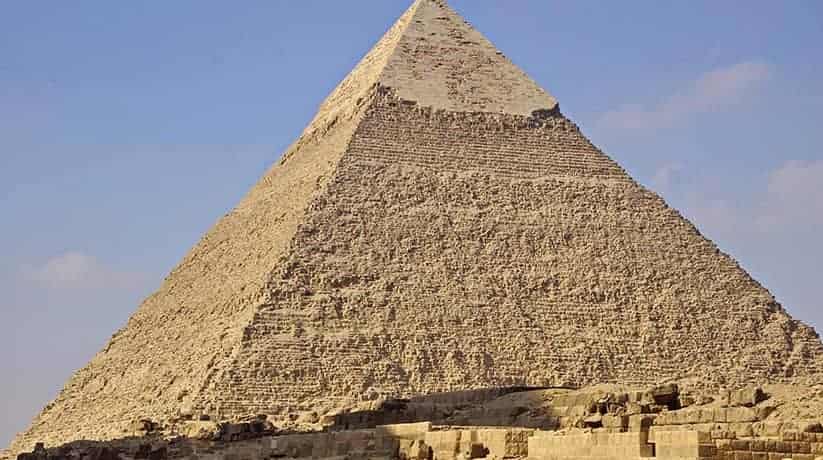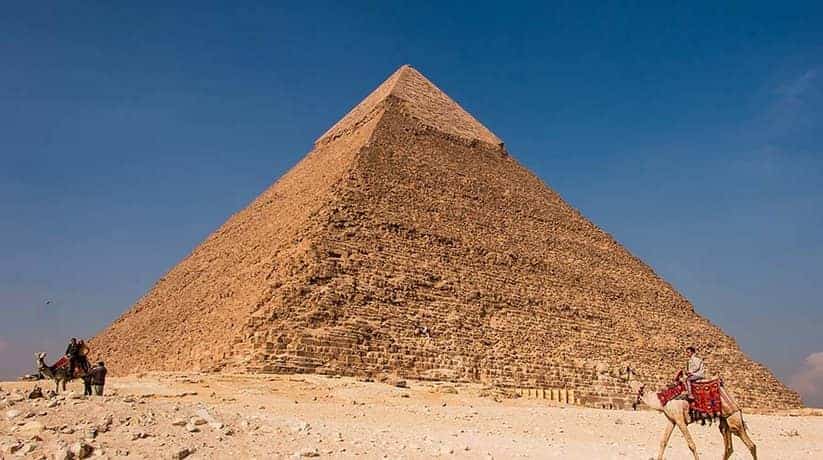Chephren Pyramid Cairo Egypt tours, booking, prices, reviews
Chephren Pyramid Cairo also called Khafre Pyramid. In fact, it is the second-tallest and second-largest of the Ancient Egyptian Pyramids. Khafre Pyramid is the tomb of the Fourth-Dynasty pharaoh Khafre (Chefren). He ruled from 2558 to 2532 BC. In fact, it often called the “Second Pyramid”. The pyramid built next to the Great Pyramid of Khufu (Cheops). In fact, Chephren is the son and successor of Khufu and Hensuten. Khufu’s other son and also Ra’djedef, started constructing his own pyramid at Abu Rawash. It is north of Giza. Chephren pyramid or Khafre Pyramid designed more modestly than Khufu’s. Moreover, the pyramid originally was 10 feet (3 m) shorter and 48 feet (14.6 m) more narrow at the base.
In fact, the estimated weight of all the stones in Chephren Pyramid Cairo or Khafre pyramid is 4,880,000 tons. Because it built higher on the plateau, the pyramid looks taller from most angles than Khufu’s pyramid. Furthermore, the slope of the angles is higher, 53 degrees in comparison to Khufu’s 51 degrees. In fact, there is no evidence that anyone ever buried in the main chamber. Moreover, no inscriptions found in the pyramid or Khafre Pyramid. There is a sarcophagus in the main chamber. There are also two entrances that lead into the pyramid. They placed one above the other. The upper entrance features 50 feet (15 m) above the ground. This is the one that used for entrance now. Furthermore, a narrow passage leads into a large limestone chamber. This passageway descends at a 25 degree angle to the chamber.
Further details about Chephren Pyramid in Cairo:
In fact, the walls lined with red granite. This inner chamber is quite large, 14.2 m x 5 m x 6.9 m. Moreover, the roof of the chamber set at the same angles as the pyramid face. It designed to take the weight of the pyramid, as is the relieving chambers in Khufu’s pyramid. The roof designed this way has worked, Chephren pyramid Cairo has not collapsed. The lower corridor is directly under the upper corridor. It once contained a portcullis, which could let down to prevent entry. This corridor declines on the same angle as the upper and eventually joins into the upper. Once joined, the passageway leads into the inner chamber. Located in the lower passage is a burial chamber. In fact, It unfinished and unused. It is in the bedrock under the pyramid.
The passageway also leads through this chamber and joins the upper corridor. The top of the Pyramid or Khafre Pyramid still has some of the limestone casing. In fact, it once covered the entire the pyramid. There is maybe a change in the method of positioning the blocks that has kept these pieces still intact. It indeed gives the appearance of a white cap on top of the Pyramid. Khufu’s pyramid, Chephren pyramid looted before it entered in 1818 by Belzoni. Furthermore, the Mortuary Temple of Chephren is to the east of the pyramid. It indeed better preserved than Khufu’s temple. Chephren’s temple is more elaborate. It is although the statues and other contents have stolen than his father’s.
More details about Chephren Pyramid Cairo:
Some of the limestone walls had granite casing, which is still present in some places. Parts of a small sanctuary, outhouses and a courtyard and a large hall with pillars still remain. Moreover, a causeway connects the Mortuary temple to the Valley Temple. It indeed better preserved than any other causeway. Furthermore, it hidden in the sands until Mariette found it in 1852. The causeway of Chephren Pyramid Cairo is also 500 m long. In fact, it lined with red granite which protects the limestone. Moreover, there are two entrances to the temple that face east. They lead into a T-shaped hall which has huge pillars. Twenty-three statues of Chephren also found in this hall. In fact, the only one which remains intact is in the Egyptian Museum. This statue is indeed the most famous Egyptian statue.
It shows Chephren sitting in his throne with a hawk perched on the back of the throne. Chambers can found on the south side of the hall at Chephren Pyramid Cairo. The passage which joined the causeway now closed off to visitors. Moreover, two entrances lead to the burial chamber. One that opens 11.54 m (38 ft) up the face of Chephren pyramid. The other one opens at the base of the Pyramid. These passageways do not align with the center line of Khafre pyramid. Rather, they offset to the east by 12 m (39 ft). The lower descending passageway carved completely out of the bedrock. It also descends, runs horizontal and then ascending. In fact, this is to join the horizontal passage leading to the burial chamber.
Further details about Chephren Pyramid Cairo:
In fact, there is an explanation why there are two entrances. It is that the pyramid intended to be much larger with the northern base. The northern base shifted 30 m further to the north. It which would make Chephrine pyramid Cairo much larger than his father’s. This would place the entrance to the lower descending passage. It is within the masonry of the pyramid. The bedrock cut away farther from the pyramid on the north side than on the west side. In fact, there is no enough room on the plateau for the enclosure wall and Chephren pyramid Cairo terrace. Furthermore, there is a subsidiary chamber. It equals in length to the c.412 long King’s Chamber of the Khufu pyramid.
The chamber opens to the west of the lower passage, the purpose of which is uncertain. It maybe used to store offerings, store burial equipment or it was a Serdab chamber. The upper descending passage is clad in granite and descends. It is to join with the horizontal passage to the burial chamber. The burial chamber carved out of a pit in the bedrock. However, the roof constructed of gabled limestone beams. The chamber is rectangular, 14.15 m by 5 m (46.4 ft x 16 ft). In fact, it also oriented east-west. Khafre’s sarcophagus carved out of a solid block of granite. It sunk partially in the floor. Belzoni found bones of an animal, possibly a bull in it. Another pit in the floor likely contained the canopic chest. Its lid would have been one of the pavement slabs.
The Valley Temple:
The valley temple of Khafre’s Giza complex is one of the best preserved Old Kingdom temples in Egypt. As a masterful work of ancient Egyptian monumental architecture, it cleared of sand. In 1869 this temple became the backdrop for the ceremonial opening of the Suez Canal. The temple fronted on the east by a large terrace. It paved with limestone slabs, through which two causeways led from the Nile canal. In the middle of the terrace, fragments of a small, wood and matting structure unearthed. They are the location of a statue depicting Khafre. Others believe that this was a tent which used for purification purposes.
In 1995, Zahi Hawass re-cleared the area in front of the Valley temple. He discovered that the causeways passed over tunnels. They framed with mud-brick walls and paved with limestone. These tunnels have a slightly convex profile resembling that of a boat. They formed a narrow corridor or canal running north-south. In front of the Sphinx Temple, the canal runs into a drain. It leads northeast to a quay buried below the modern tourist plaza. The causeways connected the Nile canal with two separate entrances. The entrances are on the Valley temple facade. They sealed by huge, single-leaf doors. They made of cedar wood and hung on copper hinges. Each of these doorways protected by a recumbent Sphinx.
More details about Valley temple:
The northern of these portals dedicated to the goddess Bastet. The southern portal dedicated to Hath. The temple laid out in almost a square ground plan. It situated just next to the Great Sphinx and its associated temple. Valley temple was a gateway or portal to the whole complex. It is like to the fore part of Khafre’s mortuary temple. Its core wall built of huge blocks that sometimes weighed as much as one hundred and fifty tons. This inner core then covered by pink granite slabs. A material used throughout the complex quarried near Aswan far to the south. This wall inclined and rounded at the top. It made the whole structure appear somewhat like a Mastaba tomb. Between the two entrances to the valley temple was a vestibule. It is with walls of simple pink granite that polished to a luster. Its floors paved with white alabaster.
A door then led to a T-shaped hall that made up a majority of the temple. This area too sheathed with polished pink granite and paved with white alabaster. It also adorned with sixteen single block pink granite pillars. They supported architrave blocks of the same material. They bound together with copper bands in the form of a swallow’s tail. These in turn supported the roof. On the south side of the roof was a small courtyard. It situated directly over six storage chambers. It built of pink granite and arranged in two stories of three units each. These embedded in the core masonry of the T shaped hall. At the other end of the cross in the T shaped hall (north), an opening gave way to a passage. It also paved with alabaster. It leads to the northwest corner of the temple and there joined the causeway.
The Cult Pyramid:
A small cult pyramid sits on the axis of the south side of Chephren Pyramid Cairo. It almost completely destroyed. Cult, or Satellite pyramids derived from the south tomb of Djoser’s complex at Saqqara. They were for the burial of statues which dedicated to the Ka, or spiritual double of the king. The cult pyramid surrounded by its own enclosure wall. It has a simple substructure. Furthermore, it consists of a descending corridor that gives way to an underground chamber. It features a T-shaped ground plan.
Furthermore, this chamber contained bits of wood and carnelian beads. It also contains fragments of animal bones and vessel lids. Maragioglio and Rinaldi concluded that it served as a tomb for one of Khafre’s consorts. Stadelmann opposed this view, believing that it was a cult pyramid. His opinion supported by the cult pyramid attached to Khufu’s complex. It is on its southeast corner.
















